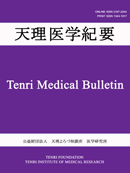Volume 21, Issue 1
Displaying 1-7 of 7 articles from this issue
- |<
- <
- 1
- >
- >|
Special Article
-
2018 Volume 21 Issue 1 Pages 1-13
Published: December 25, 2018
Released on J-STAGE: July 09, 2018
Download PDF (3151K)
Case Report
-
2018 Volume 21 Issue 1 Pages 14-18
Published: December 25, 2018
Released on J-STAGE: July 09, 2018
Download PDF (828K) -
2018 Volume 21 Issue 1 Pages 19-29
Published: December 25, 2018
Released on J-STAGE: July 09, 2018
Download PDF (2441K) -
2018 Volume 21 Issue 1 Pages 30-40
Published: December 25, 2018
Released on J-STAGE: July 09, 2018
Download PDF (3446K) -
2018 Volume 21 Issue 1 Pages 41-48
Published: December 25, 2018
Released on J-STAGE: July 09, 2018
Download PDF (2632K)
Pictures at Bedside and Bench
-
2018 Volume 21 Issue 1 Pages 49-52
Published: December 25, 2018
Released on J-STAGE: July 09, 2018
Download PDF (981K)
Meeting Report
-
2018 Volume 21 Issue 1 Pages 53-55
Published: December 25, 2018
Released on J-STAGE: July 09, 2018
Download PDF (2252K)
- |<
- <
- 1
- >
- >|
